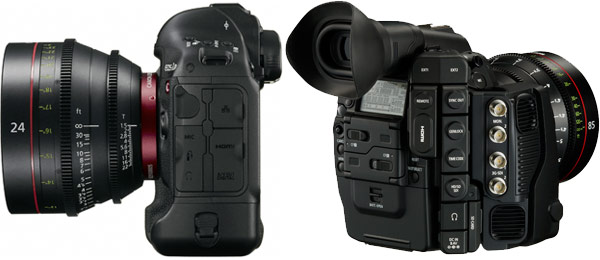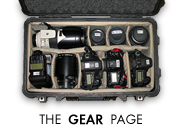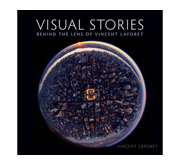Canon joins the world of 4K
This morning, Canon announced two cameras that it will be showing at NAB, along with their specs, the EOS-1D C and C500 – both 4K capable cameras.
I have seen footage from the 1D camera and it looks great. An interesting point here is that I have only seen that footage at 1080p – not 4K, and that’s going to be a consideration for most people going forward. The cameras are ahead of the monitor/projector/TV resolutions that almost all of us have today. While RED was far ahead of the curve and pushed 5K a few years ago, and now Sony, Canon and others are joining the 4K world – few if any of us can truly experience the beauty of 4K on any of the monitoring devices we currently use – and I think that’s significant.
While there’s no argument against the fact that shooting at 4K has numerous advantages for post (repositioning/pan & scan, stabilizing etc.) it’s a little bit like Apple with the Thunderbolt port – there is still a dearth of small portable drives and accessories in the Thunderbolt family… Although you can expect that to change at NAB.
Is 4K the future? Very likely so. But it’s going to be an uphill battle to get production houses to upgrade their computers, graphic cards, and monitors to fully support 4K on a first level (most systems can support it now – but RAW is another issue.) Then we’re going to need bigger pipes to deliver the content via the web. Then comes the viewing public – they too are going to need higher resolution displays and televisions, and theaters are going to need a new generation of projectors to fully appreciate these magnificent higher resolutions. The point is: it’s going to take a little while for this to happen – years, not months for most. And of course these monitors and projectors AREN’T cheap – and that’s another significant factor. I know of one friend who has shot an entire film in 5K – but it’s quite an undertaking to project it at 4K – so he’ll be projecting it at 2K in the end which I’d imagine is a tough pill to swallow. That of course will change with time… as will the prices.
The first announcement was for Canon’s 4K capable DSLR, now called the EOS-1D C. We had heard tidbits dropped about this camera back at the launch of the C300 in November, but now it’s out in the open. According to the press release, the 1D C is essentially the same 18.1 MP 1D X (but with a full frame sensor capable of shooting in Super 35mm size for video) with advanced video features. These include the capability of recording 4K to CF cards, and 60p (50p in PAL regions) recording at Full HD (4K at 24p). It also comes with the Canon Log Gamma option. These inclusions make sure that the 1D C can be used as a B-Cam to the C300 or new C500 (below). The camera records 8-bit 4:2:2 4K as a Motion JPEG, as well as Full HD. However, when recording to the CF card, Full HD is only 8-bit 4:2:0. However, the 1D C still includes only an HDMI out – so you can only pull a 4:2:2, 1080p image to an external recorder, but this also means that you can’t get a 4K out, and can only shoot to the internal CF card. You can read the official press release here. The price is to be set around $15,000.00
The second announcement was for Canon’s continuation of the C300 line – a 4K raw camera called the C500. The camera will be capable of acquiring a few different formats including, Full HD, 2K, 4K (both standard and Quad HD). Both 2K and 4K RAW (12-bit RGB 4:4:4) output can be captured to an external recorder via dual 3G-SDI ports, and an additional two HD-SDI port can be used for live monitoring. It seems RAW out of the dual 3G-SDI is the only way of recording 4K, but HD and 2K can be recorded to dual CF cards. However, while outputting 4K, the camera can record 50Mbps HD proxy to the internal CF card that can be used in post. The camera also supports frame rates of 60 fps for 4K formats and 2K formats. 2K can be shot up to 120 fps (10-bit 4:2:2). You can read the full press release here. There is no price on the C500 yeah, but both of these cameras are slated to be released later this year. The one difference from the C300 is that the side grip cannot be removed. The price will MSRP at $30,000.00
What is impressive with these two cameras is that Canon has retained their low light performance with these high resolutions – something that is very difficult to do given how much smaller each individual cell is on the sensor (the smaller the cell – the less light it can capture and therefore the less sensitive to light it tends to be.)
In addition to these two cameras, Canon also announced new cinema zoom lenses to support them. These lenses are made to shoot 4K, and are lighter and more compact than their predecessors which were released with the C300. The first is a 15.5-47mm T/2.8, and the second is 30-105mm T/2.8mm. Both lenses will be available in EF and PL mount variations. I have read that they will be in the $10K-$15K price range.
Also to support this move into 4K cinema, they have announced they will be exhibiting a 30-inch, 4K monitor – which is the next big piece of the puzzle.
Lastly – I think this is a very tough time to be a camera buyer. Which camera should one buy? With the C300 having just become available to most – now Canon has leapfrogged that camera with 4K and more importantly a camera that supports a RAW file format… Between the Canon 5D MKIII, Canon 1DX, Canon 1D C, and C500 – not to mention the RED Epic, Scarlet and Sony FS700 – there are a LOT of choices out there. And now we don’t only need to buy new cameras – but also new glass for some… and definitely new monitors, hard drives/servers to store this massive amount of data, and perhaps computers. This is not a small incremental update – but potentially a very sizable investment for individual operators and big production houses alike. Given the state of the market and the economy, it’s not the easiest pill to swallow for many. That being said, these cameras are likely aimed at the higher end productions – Hollywood and TV shows. So, as I said with the Canon C300 – the world of HDSLRs is here to stay for most of us because the quality is still impressive – and for the single biggest reason: it’s affordable to most.
I look forward to seeing the footage in full 4K at the Canon event this Sunday – and I’ll be commenting some more. What we SHOULD be celebrating as Canon shooters – is Canon’s entry into a RAW workflow for film/video – now that’s something I’ve been waiting for for a LONG time – and it’s very exciting. We should all be excited with this new technology and how it will trickle down to most of us in time.














Great post, agree mostly with what you’ve said about the slow and expensive upgrade process to a world of 4k etc.
But you mentioned that these cameras are likely aimed at high-end Hollywood/TV.
This has me puzzled… are they really? I can’t help but think that most TV stuff will stick with cameras like the Alexa *predominantly* (and its only a matter of time before that gets upgraded) as HD DigitalTV is normally just 1080i still, and really high-end features will go for the likes of the F65/Epic.
Lower budget stuff will stick with F3/c300 I reckon… leaving these new cameras, for the time being, in a bit of an odd middle ground.
Vincent Laforet Reply:
April 12th, 2012 at 12:48 pm
I agree about the odd middleground – but don’t be so quick to dismiss Canon… they’ve been making a lot of headway a lot faster than most would have thought!
Some interesting thoughts: I was thinking the same. These cameras are not just an ‘update-cameras’, they are ‘complete workflow-updates’.
Difficult choices in interesting times: I just tweeted “Interesting times for filmmakers in 6 months time the following cameras have been announced: C300, Scarlet, C500, 1D-C, FS700 and 1D-X, 5D Mk3, D800 and (a totally different tool) EX100.” and then I saw this article.
For the moment I’ll just rent the camera that fits the job (and budget). Not every corporate video needs 4K, nightfootage or even a shallow depth of field. My EX1R is still shooting 😉
Btw, you were right when we talked in Amsterdam: the C300 isn’t difficult to operate. Just learn the buttons and menus and everyone with camera experience can basicly operate it.
Couldn’t agree more, Vincent.
Regarding the 4K sensor in the C500: Well, as I understand it’s the same sensor as the one in the C300, which is also 4K as you know – so I guess that’s why there’s no difference in light sensitivity?
It seems the only difference between the two cameras is that the C500 can output that full resolution via its 3G HD SDI ports.
Looking forward to meeting you at the Kessler Party!
Vincent Laforet Reply:
April 12th, 2012 at 12:47 pm
See you then!
… shall I buy the 5D Mark III now, or what?
If the 1D-C would be sub 10.000 it would be a no-brainer…
Vincent Laforet Reply:
April 12th, 2012 at 12:47 pm
good question… you really need to think about whether or not you need 4K…. and that sub $10K number is the golden number that they keep missing…
I was hoping they’d release a slightly lower-end C300 type camera around $6K, without ND filters, SD-SDI out, and some other bells/whistles, while maintaining the 50mb/s 4:2:2 to CF card. Like you said, 4K isn’t really a priority for me right now.
I think it is interesting to look at the marketing points for each of the cameras to see what the differentiating factors are.
Canon seems to potentially be able to differentiate itself by high ISO performance (depending on how competitors like the FS700 end up faring) and by the low-cost internal 4K recording options. In many other areas the competition seems (on paper) to be ahead of them.
However, it seems odd that they chose to limit the Cinema 1D to ISO 25,600 when the stills side of the 1D X can go up to ISO 204,800. I really hope they change that in firmware later on because it seems like it could really be helpful to documentary and wildlife shooters.
Great post Vincent, You always make us think about overall cost v.s. Need, But 4K data wrangling/archiving is not as expensive as some may think, Why?, Almost all (Including small Indie) productions buy their own drives it is in the budget, and not on the backs of the DP to purchase them, So as a DP & Editor I want 4K, On the Software/Hardware side editing 4K works great and it’s getting better every year. But like you stated watching or viewing your edit it at 4K on televisions, and theaters is the hard/expensive part, and 2k seems like it will be the norm for at least a few more years.
I will be buying one of these new 4K cameras this year, Most likely not the EOS-1D C, unless it drops below 10k, waiting to see how well the Sony FS-700 fairs among the group.
Always a pleasure reading you blog Vincent.
Cheers!
that is one heavy looking camera! aas a general shooter who doesnt do film work, it’s not up my alley.
Dallas Photographer Les Wollam
Creo que tienes razón en el aspecto que a nivel de precios y calidad, es mejor por el momento esperar un poco por el 4K.
La posibilidad de transmisión en América latina, especialmente donde yo vivo en COSTA RICA, filmar en 4k sería una inversión carísima para el mercado en el que nos desarrollamos. Acá pocos son los clientes que he escuchado quieren sus producciones a 4k.
Coincido con vos que todavía el nivel y la calidad del video con las cámaras 5DM2/5DM3/7D etc, todavía alcanza para muchas horas de filmación más con estos equipos. El 4k todavía siento que es una excelente alternativa para la producción del futuro, cercano pero futuro.
VInce
I think on the computer side 4k will happen naturally, may take a couple of years.
My 2005 mac had to be pimped to the max to play 1080, my 2011 IMac just handles it without thinking
Same with consumer viewing devices, not so long ago an HD Flat screen telly was the world of the tech nerd or showy drug dealer
Now every house in the land (UK) has a big 1080 flat screen
To stay in business the telly manufacturers will be needing to persuade those 1080 flat screen owners to throw those TVs in the trash.. like everyone dumped their CRT boxes a few years ago
And that will drive 4k .. and it will be ‘affordable’
There is a “consensus” that getting theaters upgraded to project 4K is still a few years away. I don’t think this is true. Within a 25 mile radius of where I live there are 9 Movie Theaters that have a theater with 4K projection. 4 of these theaters I frequent pretty regularly.
I don’t live in a film hotspot either, I live in Baltimore, not New York or LA. Most of these theaters make a point to have a 4k movie in each of these theaters, I saw Girl With the Dragon Tattoo in 4k, it was amazing.
Data wrangling seems fairly simple, and not too cumbersome for indie film productions, for a single camera independent feature shoot, 4x 2Terabyte hard drives has proven to be plenty for making master copies, and back ups and proxies.
Love this post, because 4k and even 2k has always seemed like spec-bs. That story about the 5k film is priceless. Especially if it’s about Peter Jackson.
From this corner, everything you need to know about the state of the production industry can be found in the titles of panels at this year’s NAB conference:
http://www.nabshow.com/2012/education/super-sessions.asp
1. Making 3D Profitable, featuring James Cameron and Vince Pace
subtext: 3D isn’t profitable
2. Mobile Video and Mobile TV – Beyond Youtube
subtext: smaller!
3. The Connected Consumer
subtext: broadcast ads don’t work anymore
4. TV Syndication Going ‘Over the Top’
subtext: kiss your multiple market international revenues goodbye
5. The ‘Great Content Shift’
subtext: Wall Street is shorting media company stocks.
Sony just laid off 10,000 employees. Disney has 1 (1!) film planned for the next year, Oprah’s cable network is on the verge of bankrupsy…
The writing is on the wall and it could not be clearer: camera specs are the very least of anyone’s problems in 2012 and/or 100,000 creative professionals are absolutely frightened at what a kid in Korea or Idaho or Sierra Leone with cs6 and a HD DSLR might be able to pull off.
Canon 1D C is 18mega pixel…Mega pixel is not important? WHY
@r, Because the sensor is 18MP but the video mode (4096 x 2160) is 8.85MP, much like many competing 4K products. The 18MP is for stills only.
Great post, hit the nail on the head in terms of not just being a camera upgrade but also an expensive workflow upgrade too.
The way i see it, if 4k is not going to be on our TVs very soon, lets guess and say in the next 5 years maybe but not right now, then why buy a camera and computer system with 4k workflow now? 1080p is the standard and will remain so in my opinion for years. When 4k ‘does’ become the norm in years to come, upgrade then – better cameras will be around by then and cheaper.
In short, i cant see a justification for 4k at this time, not until TVs are in our houses able to display it. And TV stations are ready to broadcast it. I guess that only leaves cinematic use for projection on the silver screen. Were 4k really does make a difference compaired to 1080.
Paul.
Hi,
This morning, Canon announced two cameras that it will be showing at NAB, along with their specs, the EOS-1D C and C500 – both 4K capable cameras.
Andrew Childress
As a post productionist the 4K footage that I worked with on a recent shoot was almost invaluable.
The scale allowed me to cut and crop in to some very unusual and awkward-to-shoot footage and gave me that added flexibility.
Then there’s the color depth. Most of it was shot under very poor lighting and, without a very expensive and excessive lighting rig, there was no decent way to improve on this. It was sheer disbelief that amount of color I was able to draw back out of the footage to produce a decent end image.
Was this for Hollywood? Was it even for a low budget film? Nope, it was just for a 5 minute film for a UK manufacturer but, without 4K, I’d never have been able to achieve the final piece I’ve managed so there’s certainly a big future for it!
I Think canon missed the boat. The revolution started with cameras that where under 5k. I think sony will win(sad). This is the age where the common man can make a film and 15k is not the common man. you guys have missed the point. Most people who follow your site can’t afford a 15k camera . Canon has lost touch with who created the interest for these cameras in the first place. Canon has not made a great Film camera for under 5k and the could have done it but chose to kiss up to the old school film and media industry, Sad
@r, because 1920×1080, what you call 1080p is 2megapixels only. But if you’re a photographer going for hires large format prints you might want to focus on megapixels. 18megapixels is enough already though.
Thanks Vincent.
Always insightful & pragmatic.
Best,
Scott
OK, as a veteran stills shooter doing motion now: why hold onto this form factor? I worked with the C300 yesterday and it handles really well. I also worked with the Nikon D4 and that I get- awesome stills, great video as needed but for a 4k camera to be in a DSLR body?
Great information and insight Vincent, thank you for sharing!
I, for one, welcome our new canon overlords 🙂
Vincent, Does the C500 have XLR mic inputs? I don’t see anything in your blog or any pictures of them. Unless, I missed something.
Thanks, Keith Brown
Vincent Laforet Reply:
April 14th, 2012 at 2:33 pm
I’ll have to see in person tomorrow …. not sure.
I am a bit miffed about the 1D C. Looking at the specs, it seems like a great camera. It seems to has (almost) everything in terms of film funcitons that the current DSLR setup is lacking, especially the clean 4:2:2 HDMI output! (And yeah, 4K is not bad either.)
Then again, it got me thinking: It seems to be the same hardware platform which would mean that it is just a software upgrade. Wait a minute! Canon demands real money for having clean HDMI output and managing to process 4K images? In earlier times, this might have been covered by a free firmware upgrade!
So it’s clear that Canon is now increasingly in the business of selling software (=”features enabled by firmware”) rather than hardware (=”features enabled by hardware”). The pricing also indicates this: 5D III < 1D X < 1D C < C300 < C500.
The setup makes sense, from a product marketing point of view. Whether it makes sense from a buyers point of view is an entirely different issue. If Nikon releases a DSLR with clean 4:2:2 HDMI output at the price of or even below the 1D X then Canons entire "strategy" could be falling like a house of cards.
As some post says, crisis is everywhere, so if prices pass 6-7.000 euros those cameras go to productions that currently use RED & ARRI Alexa.
Still needed a 1080 camera like the C300 below 10.000 €
Perhaps if PANASONIC develops the 101 with the smaller sensor to 35mm size at 6-7.000 k then will be a huge hit.
Expect many years 1080. Noway 2-5 years to 4k televisions…neither quick upgrade editions to 4k. We all are waiting for a 35mm sensor 4:2:2 output by 4-6.000 euros, don’t we?
@Vincent Laforet, Sony seems to win the race this year. They have been on a very pleasing track for some time now. The FS700 is the most interesting camera in the sub 10.000 area.
I am thinkingt now about getting the FS100 (the FS700 would be a good stretch…) – it just has to come down at least a couple of hundred bucks, I am hoping. But knowing Sony, they propably won’t adjust the pricing, like they usually don’t do. The FS700 is just multiple times better for less than double the money of the FS100.
Most people are just terribly disappointed that Canon is clearly abandoning those who bought 5D Mark II solely for video and made Canon a player in the cinema business in the first place.
Well, off to scraping more money together.
@KEITH BROWN, Yes it does, on the top handle just like the C300
Vincent Laforet Reply:
April 15th, 2012 at 3:24 pm
Correct – saw it today.
@Vincent Laforet,
You’re the man!!! Thanks for remembering. Hopefully, you’ll get the chance to post some footage examples soon. This sounds like the “end all” camera. At least, until TV’s catch up to 5K resolution.
Amazing layout, I’m digging the foto up the top, gives it a cool alprazolam feel to the site!
Hey Vincent,
Did you get a chance to check out the Blackmagic Cinema Camera? Seems pretty impressive from what I’ve read. I would love to hear your take on this one!!!
Link below:
http://www.blackmagic-design.com/products/blackmagiccinemacamera/
-Keith Brown
Coldhearted Films
You actually make it appear so easy along with your presentation however I find this topic to be actually something that I feel I would never understand. It sort of feels too complicated and very large for me. I’m taking a look forward for your subsequent publish, I’ll try to get the dangle of it!
By the end of this year, AMC, the US’s largest theater chain will have converted all of it’s theaters to 4k projection.
@Wendell Adkins, Good Point… That will be amazing. I can’t wait to see what that looks like.
The 1D C is a pretty amazing piece of equipment, just shot with it last week.
However I did shoot some stills in RAW, and so far…none of my software will open the files :-/ . I’m fine with the 1D X files, but any idea how to get these 1D C files open?
The video is fine, just having a problem with the stills portion.
Thanks!
Matt
Vincent Laforet Reply:
October 3rd, 2012 at 7:16 am
You should have Canon software to open it – it usually takes Adobe and Apple a few weeks to catch up with RAW updates as they actually have to do an update to ACR or the system.
@Vincent Laforet, Thanks, Yeah only Image Browser seems to recognize the files…but still won’t allow for export or anything other than just looking at them.
I’m working on it. Will let you know if i find anything soon.
Thank for the reply,
Matt
So what do you all think that what are the issues with 4K camera workflow?
Vincent Laforet Reply:
October 25th, 2012 at 12:26 am
A LOT more data to process… affects your monitor / CPU / RAM / Drive etc… but we’ve had not issue w/ 5K and Premiere.
Hi there I am so happy I found your website, I really found you by mistake, while I
was researching on Yahoo for something else, Nonetheless I
am here now and would just like to say thanks a lot for a marvelous post and a all round thrilling blog (I also love the theme/design), I don’t have time to look over it all at the minute but I have bookmarked it and also included your RSS feeds, so when I have time I will be back to read a lot more, Please do keep up the superb work.
Everything you have touched on concerning 4k and beyound makes complete logical sence. The one thing I was wondering is: Doe’st filming in 2k or 4k improve the picture quality when shown in a 1080p format? Sharper, Cleaner, better low light manipulation?
Vincent Laforet Reply:
February 18th, 2013 at 6:55 am
Yes. Always. But you’d only probably notice the difference in a theater or top of the line Blue Ray… always hard when it comes to compression on TV / Web etc to justify.
Would sensor overheating be a problem with 1 hour of 4K video? I am planning to do marine archealogy and to scan entire wrecks with the limitation of 2×128 GB media, i.e. 1 hour. The 1DC would be housed in a tight aluminium underwater housing with hardly any air circulation. But, the housing is cooled continuously by 4-20 degree Celsius water.
Vincent Laforet Reply:
March 31st, 2013 at 8:03 pm
It could be. Definitely…
Thanks Vincent for your fast reply. I really appreciate it.
Any idea of a realistic 4K clip length (even in open, room temperature, air) before the camera shuts down?